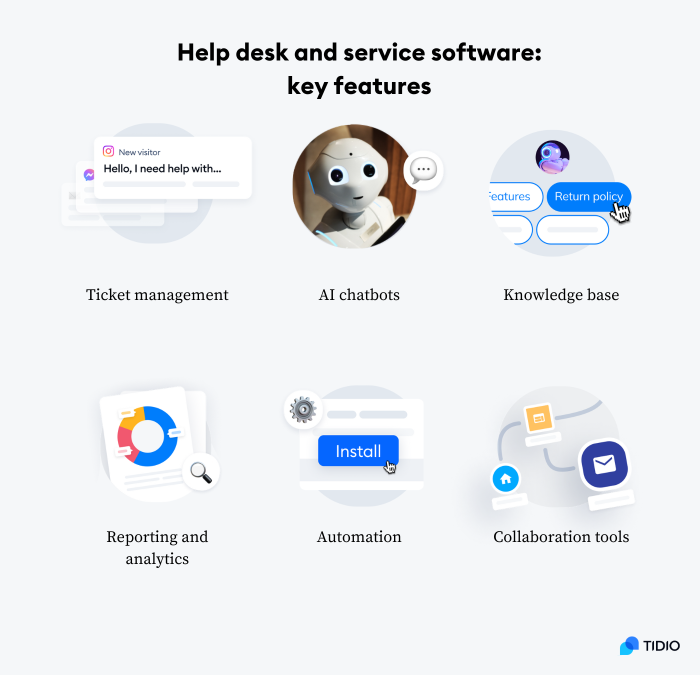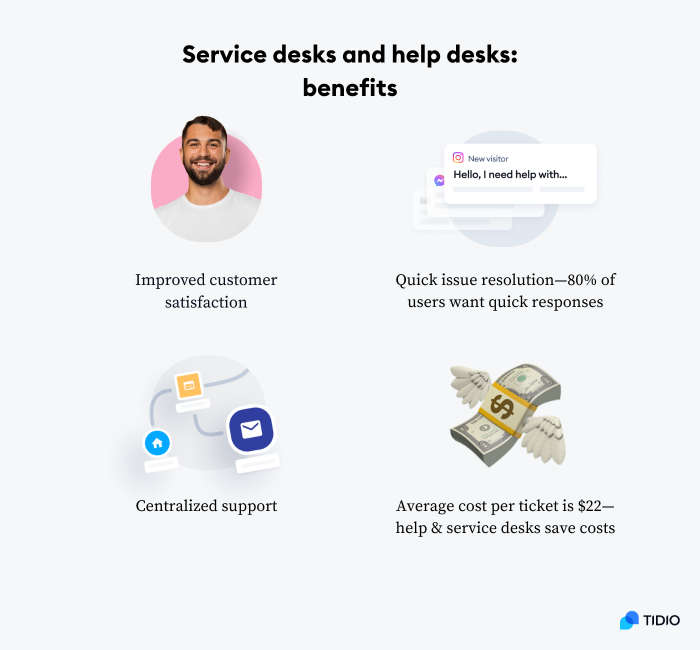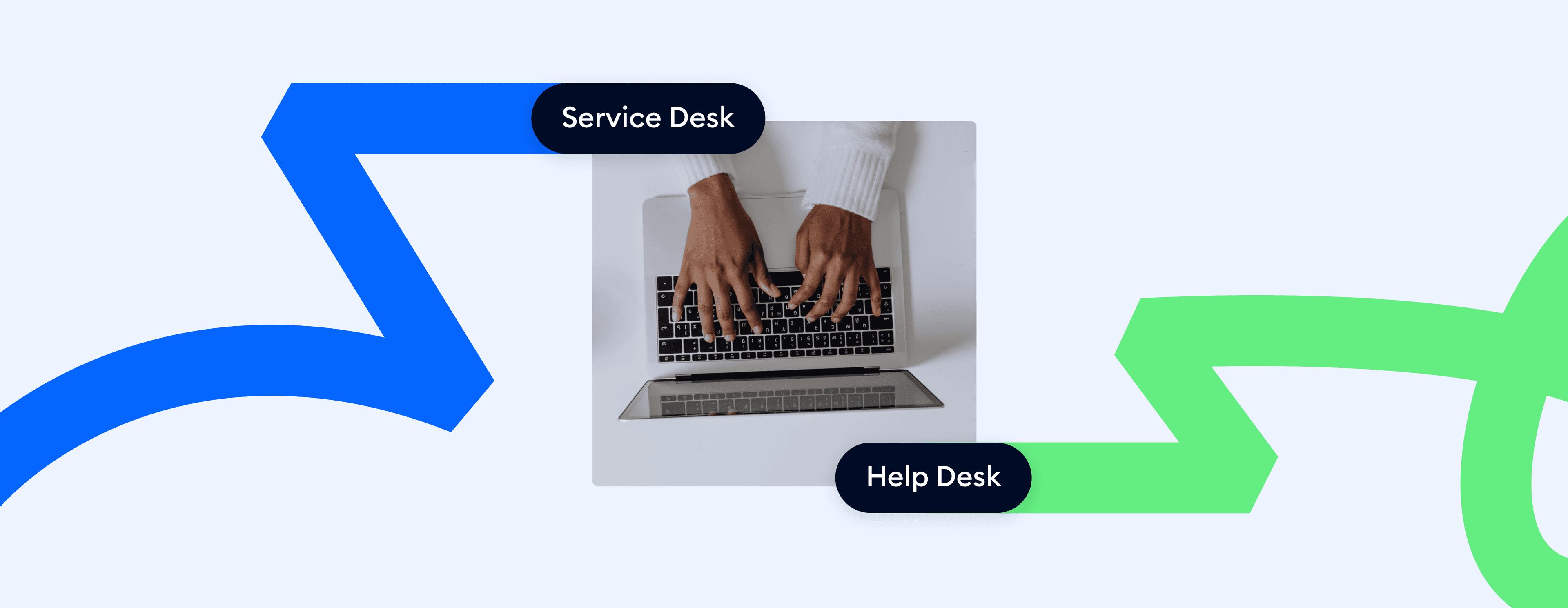Many businesses use the terms “help desk” and “service desk” interchangeably, but there are some key differences between the two.
While a help desk has a more limited scope focused on troubleshooting issues and is more customer support-oriented, the service desk is used for IT support within the company and adopts an all-encompassing approach across the entire service lifecycle.
In other words, a help desk is reactive, addressing issues as they arise, while a service desk is proactive, aiming to prevent issues and optimize IT processes.
But there’s much more to the story.
Stay tuned as we explain the core functions and discover the main benefits of each. Also, we’ll discuss when to implement a help desk vs. service desk based on your business needs.
Use a powerful help desk system and deliver outstanding support
Let’s cut straight to the chase—
What is the difference between help desk and service desk?
Both systems involve providing technical support to users. And while the two terms may sound identical at first, there are some traits that can help you distinguish one from the other.
Here is a comparison table of the main differences between an IT help desk vs. IT service desk:
| Help desk | Service desk | |
|---|---|---|
| Scope | Focused on troubleshooting and incident management | Full scope of IT services, including problem, change, and service request management |
| Approach | Reactive—responding to issues when they arise | Proactive—long-term focus on preventing issues before they occur |
| Focus | Quick-fix solutions to end-users | Strategic, company-wide processes aligned with ITSM best practices |
| Automation | Less automation, more manual work | Extensive automation for handling repetitive tasks |
| Metrics | Basic metrics (e.g., ticket volume, resolution time) | Advanced metrics (e.g. first call resolution, SLA breach rate) |
| Tools | Basic ticketing system | More advanced customer service software integrated with ITSM tools |
| Staffing | General, front-line support agents | ITIL-trained professionals with specialized roles |
| Budget | Lower costs | Higher investment due to advanced tools and expertise required |
So, a help desk provides basic break-fix technical support (or incident management), while a service desk focuses on more complex IT service management.
It could also be said that a help desk offers help to customers, whereas a service desk provides full-blown IT service to users.
That being said, there are still organizations that view service and help desks as one and the same and use the two terms interchangeably, which can potentially make the distinction between the two more confusing.
Read more: Learn all you need to know about Tidio’s ticketing system and how to set it up for the most efficient customer query management.
Okay, let’s look at each of the systems in more depth—
What is a help desk?
A help desk primarily provides reactive, break-fix support to users, acting as the first point of contact when customers encounter problems. Its main goal is to quickly resolve these issues, making it an essential resource for addressing immediate concerns. Though help desks are often associated with technical support, this model applies to various industries.
For example, in the retail sector, an ecommerce help desk might assist employees with point-of-sale system failures or inventory tracking glitches. In healthcare, help desks help resolve issues with patient management software or hospital equipment malfunctions. These solutions can also improve patient engagement by providing quicker resolutions to technical issues, leading to a smoother healthcare experience. And in the finance industry, a help desk could troubleshoot issues related to online banking or transaction systems.
Here are the key features of a help desk:
- Incident management—help desks focus on resolving issues like system crashes, software errors, or product malfunctions. For instance, in a manufacturing plant, this could involve troubleshooting equipment failures or addressing downtime in automated systems.
- Ticketing system—help desks utilize ticketing systems to log, track, and resolve customer issues. This system is crucial not only in IT but also in hospitality, where it may manage guest requests or maintenance issues in a hotel.
- Self-service portal—many help desks offer self-service portals that include knowledge bases, FAQs, and guides. This feature empowers users to solve common problems independently, whether it’s a customer resetting a password on an ecommerce site or an employee accessing training materials in a corporate environment.
Help desk agents play a vital role in diagnosing and resolving routine issues, while more complex problems are escalated to specialized teams like network administrators, software developers, or in a retail setting, supply chain specialists. The reactive nature of a help desk means it responds to the issues as they arise.
Tidio is a good example of a tool that offers a help desk system:
Now—
What is a service desk?
A service desk goes beyond merely fixing technical problems. It’s responsible for handling not just incidents, but also problem and configuration management, change management, and service requests. In addition, the service desk uses more advanced ITSM (IT service management) tools to automate processes such as ticket routing, knowledge management, and reporting. As such, it’s operated by ITSM professionals.
Key features of a service desk include:
- IT service lifecycle management—managing the entire lifecycle of IT services, including proactive maintenance and long-term planning to prevent future issues
- Automation and ITIL integration—using automation tools to streamline repetitive tasks while following ITIL (Information Technology Infrastructure Library) practices
- Strategic business alignment—unlike help desks, service desks focus on aligning IT services with business objectives, ensuring IT plays a key role in driving business growth
Jira Service Management is a great example of a service desk tool:
In a nutshell, a service desk is an advanced version of a help desk that offers a full scope of IT services to customers. It helps teams provide complete technical guidance to users and organizations regarding any products or services. These can include any kind of technology used by a user or employee, be it laptops, apps, or even servers.
So, it’s safe to say that a service desk evolves from a help desk, but it incorporates a wider scope of ITSM practices in comparison.
Speaking of, it’s also important to clarify the following—
What is an IT service management (ITSM)?
IT service management (ITSM) is simply an approach that organizations use to operate and deliver IT services to customers. ITSM promotes the idea of delivering IT like a service, with a strong emphasis on business processes, clients, and measurement.
The essential processes of ITSM include:
- Incident management
- Problem management
- Change management
- IT asset management
- Request fulfillment
Typically, companies that use a service desk engage in many of these ITSM activities.
Help desks can use some of the practices from IT Service Management, but they generally focus on a more limited scope compared to a service desk. While service desks are designed to handle the full range of ITSM processes, help desks typically concentrate on incident management (resolving immediate technical issues) and request fulfillment (handling simple user requests).
That said, help desks may not usually engage in broader ITSM processes like problem management (finding the root cause of recurring issues), change management (coordinating changes in IT systems), or IT asset management (tracking and managing IT resources), which are more often the domain of a service desk.
Moving on—
What are the essential features of help desk and service desk tools?
Help desk and service desk tools: key features
The ideal software solution should always contain functionalities that match your organization’s specific needs.
Here are some of the essential features to consider when evaluating your options:

- Ticket management—these will allow you to easily create, assign, track and resolve support tickets
- AI chatbots—having AI customer service features and chatbot technology can automate your support processes and provide quick responses to the FAQs
- Self-service portals—as a repository of solutions to common issues, these can include anything from user guides, commonly asked questions, and knowledge base articles
- Reporting and analytics—performance and productivity reports to keep track of your most important metrics
- Automation—these include features like ticket routing, resolution, and escalation
- Collaboration tools—shared inbox with internal messages, valuable for agents to communicate with ease and share knowledge
Read more: Check out some of the vital chat handling skills your agents need to deliver excellent customer service.
Boost client satisfaction with a help desk solution
Whether you end up using help desk or service desk software, now you know which features you can expect to find.
But how to know which option is the best for you?
Help desk or service desk: which one to choose?
So, taking into account all we said above, how do you know which solution to pick for your specific needs?
Here are some guidelines on whether your company should implement an IT help desk vs. service desk.
You should go for help desk if you:
- need a basic system to track IT tickets and provide first-level tech support
- own a small to medium-sized business with limited IT infrastructure and staff
- need a good entry point for early-stage IT service management
- have basic user support needs but don’t have much investment
You should choose service desk if:
- your IT environment and user base scales significantly in size and complexity
- strategic management and improvement of IT services becomes crucial
- you need to enable mature ITSM processes and practices
- help desk is clogged up with too many routine break/fix requests
Read more: Check out the best open source help desk tools on the web.
With that out of the way, let’s take a look at how help desks and service desks can benefit your business.
The benefits of service desks and help desks
Despite their differences, both help desks and service desks provide valuable benefits to businesses, especially when it comes to efficiency, centralized support, and client satisfaction.
Let’s take a look at each one:

- Improved customer satisfaction—quick access to support helps users resolve issues promptly, reducing frustration and increasing satisfaction.
- Faster issue resolution—service desks streamline incident management, while help desks route queries effectively. With 80% of customers expecting quick responses, speed is crucial.
- Centralized support—both systems provide a single hub for handling requests, improving issue tracking and collaboration between agents and IT teams for better productivity.
- Cost reduction—automating routine tasks and offering self-service options can cut support ticket volume and significantly lower IT costs, with savings averaging $22 per ticket.
Read more: Find out how Gecko Hospitality reached 90% customer service automation using Tidio.
IT service desk vs. help desk: key takeaway
So, let’s sum up:
A help desk focuses on reactive, break-fix support, helping businesses resolve immediate technical and non-techincual issues. It’s a great fit for smaller organizations with straightforward IT needs, such as startups or retail businesses, or companies in industries like healthcare or education that require quick, efficient solutions to manage inquiries at a lower cost.
On the other hand, a service desk offers a proactive, business-centric approach that focuses on long-term IT management and aligning IT services with business goals. For larger organizations with complex IT environments, the service desk provides strategic value by improving processes and ensuring IT service quality.
In general, a help desk can be considered a subset of the service desk. Businesses tend to switch from help desks to service desks as their IT infrastructure and user base grows larger and more complex.
That being said, which system type you’ll go for depends on your business goals, size, and other IT-specific requirements. So, make sure to choose the right service provider accordingly.

